Luscious Lasagna Know-How!
Let’s talk about perfect pasta—lasagna noodles, specifically. There’s more to knowing how to cook these noodles than one would guess.
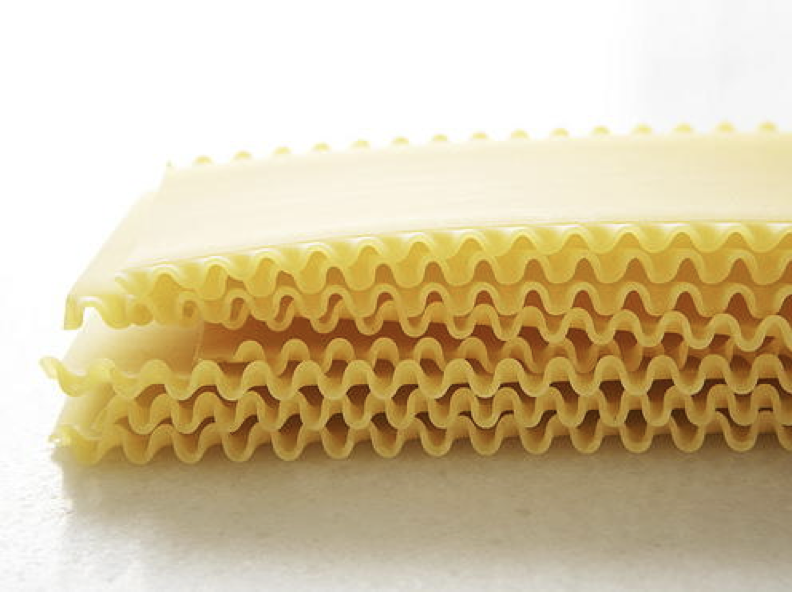
Because lasagna noodles are cooked twice, they can easily become too soft. If you use regular packaged noodles, don’t wander away from the stove when you put them on to boil. The noodles should be removed from the heat and drained just before they reach the firm-tender stage.
What is the “firm-tender” stage? Another way of putting it is “al dente”—Italian phraseology that means “to the tooth.” It describes the texture of cooked pasta when it’s tender but firm and chewy when you bite into it. If your pasta is mushy and soft, you’ve blasted right past al dente and into well done.
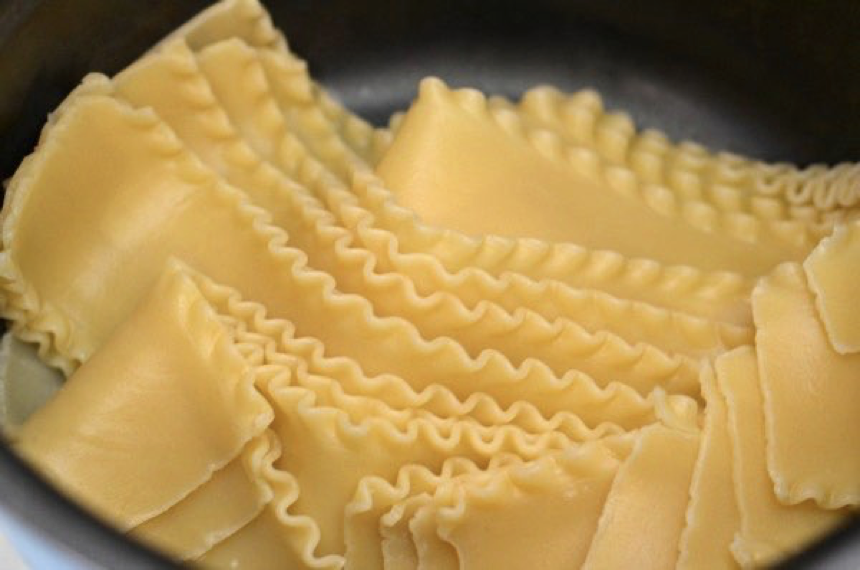
The only way you can really KNOW is your lasagna noodles are ready to remove from the water is to take a bite. You want to remove them just before they get chewy. This means they’ll be just a little crunchy still.
Besides knowing when to remove this wide noodle from the water, you also want to know how to deal with their sticking issues (due to their width and length). More than other pastas, they tend to stick to each other in the pot. Also, considering they have to be set aside while the lasagna is being assembled, they like to stick to whatever surface they’re on while they cool. All this means that as you try to pull the noodles apart, they tend to rip. Oh joy.
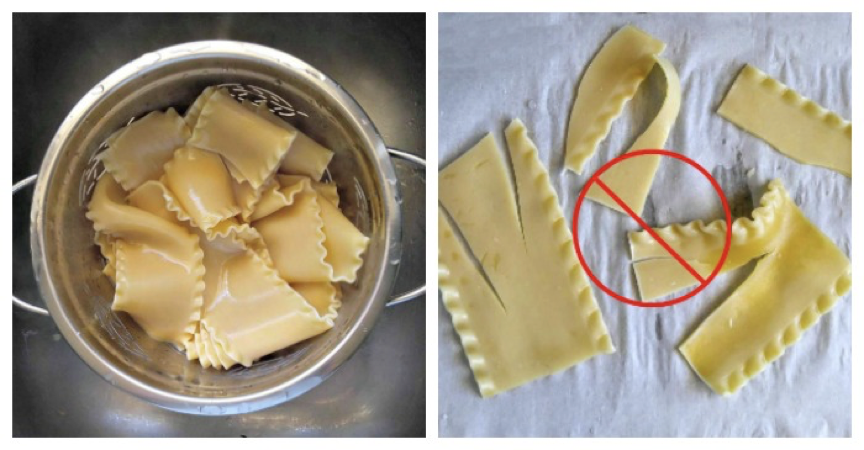
So what to do? While adding a tablespoon or so of olive oil to the cooking water for most varieties of pasta should be avoided, it can be the right thing to do when cooking lasagna noodles. The oil helps prevent them from sticking together as they cook. The alternative is to cook just a few at a time, removing them with tongs when they’re done. This is too much messin’ around for me, though.
And don’t believe those cookbooks that tell you to rinse the noodles in cold water after they’re drained. Rinsing causes lasagna to become watery and to fall apart when cut. That’s because rinsing away the starch eliminates its ability to absorb moisture during baking and “glue” the lasagna together. Also, if the noodles aren’t properly dried after rinsing, they absorb excess water and thus add to the liquid in the baking pan. Not good.
The best thing to do is to simply drain the noodles and immediately lay them flat on cotton towels. The moisture on their steaming surfaces will evaporate quickly and the starch will be retained. Then assemble the lasagna quickly before the noodles have a chance to stick.
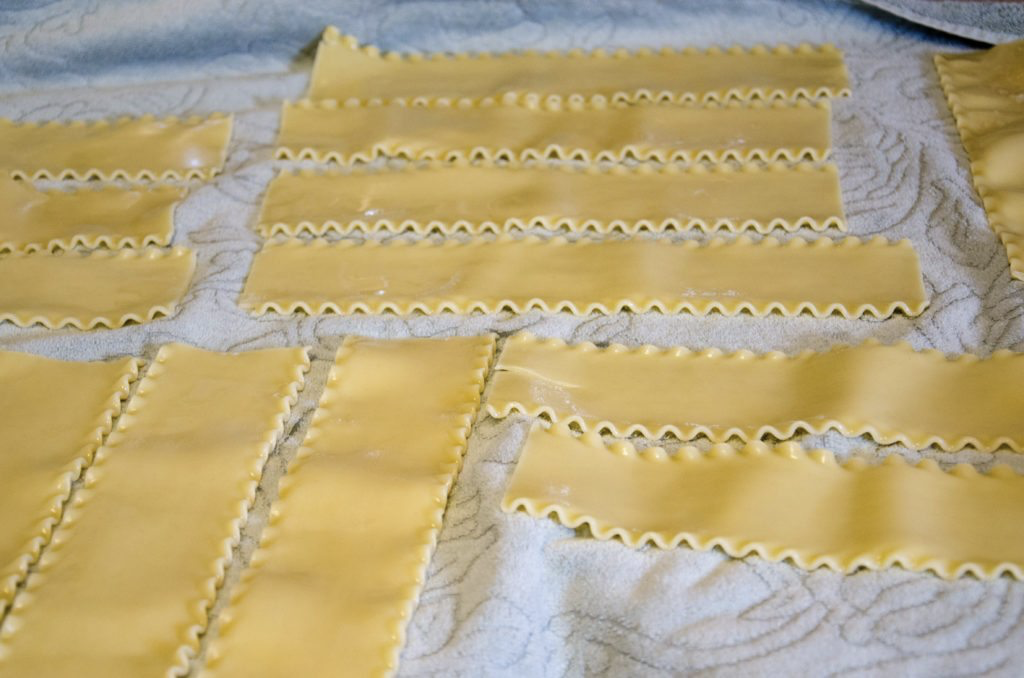
So far, this reads like a pitch for a dish to avoid. Too much bother on so many levels. BUT, all this “knowing when to remove from the water and how to avoid sticking noodles” business can be totally eliminated with one simple trick: DON’T COOK THE NOODLES!
I’m sure many of you seasoned Cook’n cooks already know this, but for those that don’t: Assemble your lasagna recipe with uncooked noodles, but increase the liquid (pasta or tomato sauce) and the amount of grated cheese. The noodles will absorb the extra sauce and fat released from the cheese and you’ll end up with a perfect al dente dish—a luscious lasagna. And best of all, your assembly time is cut by more than half! (See below for a recipe using this technique.)
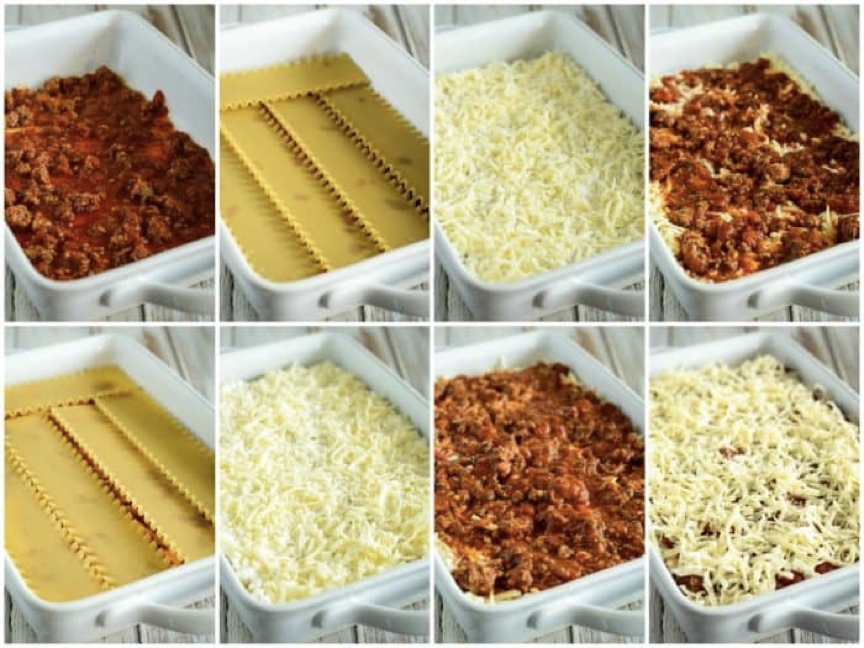
Finally, don’t we all love how this perfect party dish can be assembled several hours ahead of baking time and held in the refrigerator? One thing to note: If you bake yours straight from the fridg, add 10 or 15 minutes to your cooking time to compensate for its cool temperature. I also like to assemble two pans-worth, bake them both, then freeze one for later use.
Hot tip: If you plan to freeze lasagna after baking, line the pan with enough heavy-duty foil to come up and way over the sides (so it will completely cover the dish). Bake as directed and cool completely before sealing the foil and freezing. Then after it’s frozen solid, I remove it from the pan it’s in, slip it into an appropriate-sized plastic bag and place it back in the freezer. This way you’ll have your frozen lasagna and your dish to reuse now. Be sure to re-bake within 3 months.
To reheat, return the frozen lasagna to the original baking pan and thaw for about a day in the refrigerator. Undo the wrapping, but cover the lasagna loosely with the foil. Bake at 325 degrees for about 30 minutes or until heated through.
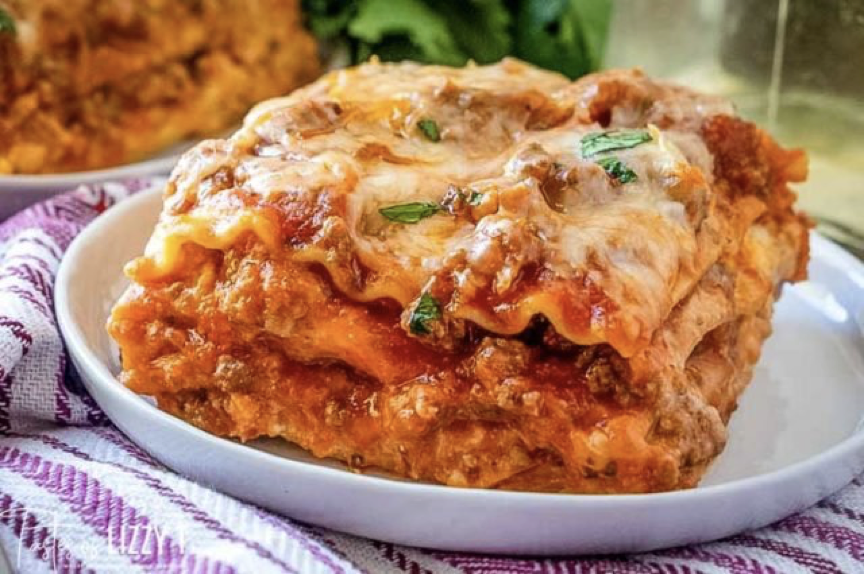
1 1/4 pounds Italian sausage
1 (28-ounce) jar spaghetti sauce of your choice
1 (14 1/2-ounce) can diced tomatoes
1 1/2 cups water
1 clove garlic minced
1 1/2 teaspoons Italian seasoning
12 ounces ricotta cheese (about 3/4 small container); cottage cheese is a perfect substitute
3 1/4 cups grated mozzarella cheese divided
1 cup grated Parmesan cheese
2 eggs
1 tablespoon parsley
1/2 teaspoon ground black pepper
1 (8-ounce) package lasagna noodles UNCOOKED
Directions:
Add Recipe to Cook'n

Because lasagna noodles are cooked twice, they can easily become too soft. If you use regular packaged noodles, don’t wander away from the stove when you put them on to boil. The noodles should be removed from the heat and drained just before they reach the firm-tender stage.
What is the “firm-tender” stage? Another way of putting it is “al dente”—Italian phraseology that means “to the tooth.” It describes the texture of cooked pasta when it’s tender but firm and chewy when you bite into it. If your pasta is mushy and soft, you’ve blasted right past al dente and into well done.

The only way you can really KNOW is your lasagna noodles are ready to remove from the water is to take a bite. You want to remove them just before they get chewy. This means they’ll be just a little crunchy still.
Besides knowing when to remove this wide noodle from the water, you also want to know how to deal with their sticking issues (due to their width and length). More than other pastas, they tend to stick to each other in the pot. Also, considering they have to be set aside while the lasagna is being assembled, they like to stick to whatever surface they’re on while they cool. All this means that as you try to pull the noodles apart, they tend to rip. Oh joy.

So what to do? While adding a tablespoon or so of olive oil to the cooking water for most varieties of pasta should be avoided, it can be the right thing to do when cooking lasagna noodles. The oil helps prevent them from sticking together as they cook. The alternative is to cook just a few at a time, removing them with tongs when they’re done. This is too much messin’ around for me, though.
And don’t believe those cookbooks that tell you to rinse the noodles in cold water after they’re drained. Rinsing causes lasagna to become watery and to fall apart when cut. That’s because rinsing away the starch eliminates its ability to absorb moisture during baking and “glue” the lasagna together. Also, if the noodles aren’t properly dried after rinsing, they absorb excess water and thus add to the liquid in the baking pan. Not good.
The best thing to do is to simply drain the noodles and immediately lay them flat on cotton towels. The moisture on their steaming surfaces will evaporate quickly and the starch will be retained. Then assemble the lasagna quickly before the noodles have a chance to stick.

So far, this reads like a pitch for a dish to avoid. Too much bother on so many levels. BUT, all this “knowing when to remove from the water and how to avoid sticking noodles” business can be totally eliminated with one simple trick: DON’T COOK THE NOODLES!
I’m sure many of you seasoned Cook’n cooks already know this, but for those that don’t: Assemble your lasagna recipe with uncooked noodles, but increase the liquid (pasta or tomato sauce) and the amount of grated cheese. The noodles will absorb the extra sauce and fat released from the cheese and you’ll end up with a perfect al dente dish—a luscious lasagna. And best of all, your assembly time is cut by more than half! (See below for a recipe using this technique.)

Finally, don’t we all love how this perfect party dish can be assembled several hours ahead of baking time and held in the refrigerator? One thing to note: If you bake yours straight from the fridg, add 10 or 15 minutes to your cooking time to compensate for its cool temperature. I also like to assemble two pans-worth, bake them both, then freeze one for later use.
Hot tip: If you plan to freeze lasagna after baking, line the pan with enough heavy-duty foil to come up and way over the sides (so it will completely cover the dish). Bake as directed and cool completely before sealing the foil and freezing. Then after it’s frozen solid, I remove it from the pan it’s in, slip it into an appropriate-sized plastic bag and place it back in the freezer. This way you’ll have your frozen lasagna and your dish to reuse now. Be sure to re-bake within 3 months.
To reheat, return the frozen lasagna to the original baking pan and thaw for about a day in the refrigerator. Undo the wrapping, but cover the lasagna loosely with the foil. Bake at 325 degrees for about 30 minutes or until heated through.

NO BOIL Lasagna
Ingredients:
1 1/4 pounds Italian sausage
1 (28-ounce) jar spaghetti sauce of your choice
1 (14 1/2-ounce) can diced tomatoes
1 1/2 cups water
1 clove garlic minced
1 1/2 teaspoons Italian seasoning
12 ounces ricotta cheese (about 3/4 small container); cottage cheese is a perfect substitute
3 1/4 cups grated mozzarella cheese divided
1 cup grated Parmesan cheese
2 eggs
1 tablespoon parsley
1/2 teaspoon ground black pepper
1 (8-ounce) package lasagna noodles UNCOOKED
Directions:
1. Heat oven to 350.
2. In large pan, brown Italian sausage; drain.
3. Add spaghetti sauce, diced tomatoes, water, garlic and Italian seasoning. Cover and simmer for 10-15 minutes.
4. In medium bowl, combine ricotta, 2¼ cups of the mozzarella, parmesan, eggs, parsley and pepper. Mix well.
5. Pour about 1 cup of the sauce on bottom of 9x13 pan.
6. Arrange 3 uncooked lasagna noodles over sauce; cover with about 1 cup sauce.
7. Spread 1/2 the cheese filling over sauce.
8. Repeat layers of lasagna, sauce and cheese filling.
9. Top with layer of lasagna and remaining sauce; sprinkle with remaining 1 cup mozzarella cheese.
10. Cover with foil and bake at 350 for 45 minutes.
11. Remove foil; bake an additional 15 minutes.
12. Let stand 10 minutes before cutting.
2. In large pan, brown Italian sausage; drain.
3. Add spaghetti sauce, diced tomatoes, water, garlic and Italian seasoning. Cover and simmer for 10-15 minutes.
4. In medium bowl, combine ricotta, 2¼ cups of the mozzarella, parmesan, eggs, parsley and pepper. Mix well.
5. Pour about 1 cup of the sauce on bottom of 9x13 pan.
6. Arrange 3 uncooked lasagna noodles over sauce; cover with about 1 cup sauce.
7. Spread 1/2 the cheese filling over sauce.
8. Repeat layers of lasagna, sauce and cheese filling.
9. Top with layer of lasagna and remaining sauce; sprinkle with remaining 1 cup mozzarella cheese.
10. Cover with foil and bake at 350 for 45 minutes.
11. Remove foil; bake an additional 15 minutes.
12. Let stand 10 minutes before cutting.
Recipe formatted with the Cook'n Recipe Software from DVO Enterprises.
Sources:
www.cookstr.com
www.tilthallianceblog.com
www.recipesjust4u.com
www.creationsbykara.com
www.pipandebby.com
www.tastesoflizzyt.com
 Alice Osborne
Alice Osborne
Weekly Newsletter Contributor since 2006
Email the author! alice@dvo.com
